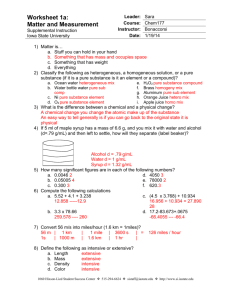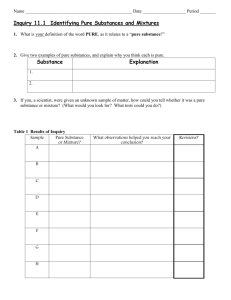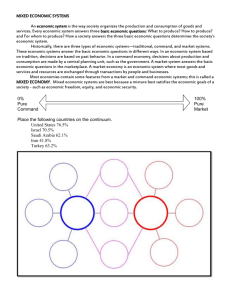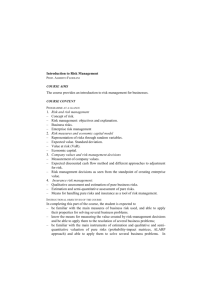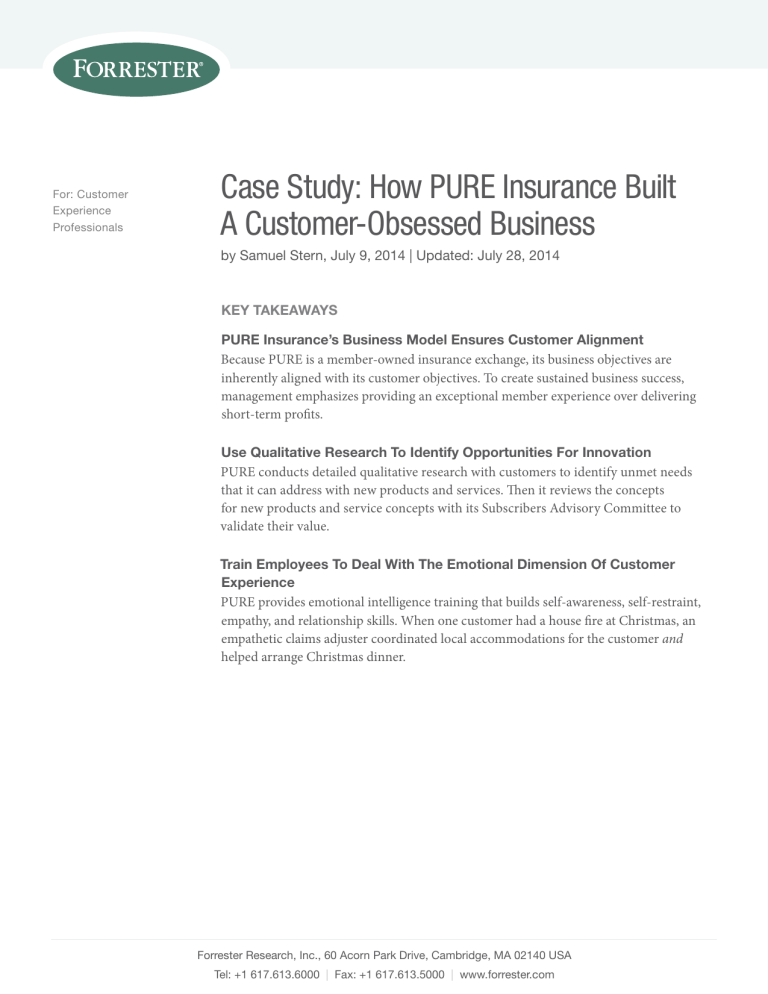
For: Customer
Experience
Professionals
Case Study: How PURE Insurance Built
A Customer-Obsessed Business
by Samuel Stern, July 9, 2014 | Updated: July 28, 2014
Key Takeaways
PURE Insurance’s Business Model Ensures Customer Alignment
Because PURE is a member-owned insurance exchange, its business objectives are
inherently aligned with its customer objectives. To create sustained business success,
management emphasizes providing an exceptional member experience over delivering
short-term profits.
Use Qualitative Research To Identify Opportunities For Innovation
PURE conducts detailed qualitative research with customers to identify unmet needs
that it can address with new products and services. Then it reviews the concepts
for new products and service concepts with its Subscribers Advisory Committee to
validate their value.
Train Employees To Deal With The Emotional Dimension Of Customer
Experience
PURE provides emotional intelligence training that builds self-awareness, self-restraint,
empathy, and relationship skills. When one customer had a house fire at Christmas, an
empathetic claims adjuster coordinated local accommodations for the customer and
helped arrange Christmas dinner.
Forrester Research, Inc., 60 Acorn Park Drive, Cambridge, MA 02140 USA
Tel: +1 617.613.6000 | Fax: +1 617.613.5000 | www.forrester.com
July 9, 2014
Updated: July 28, 2014
For Customer Experience Professionals
Case Study: How PURE Insurance Built A
Customer-Obsessed Business
by Samuel Stern
with Harley Manning and Dylan Czarnecki
Why Read This Report
From its founding in 2006, Privilege Underwriters Reciprocal Exchange (PURE) set out to create a
customer-obsessed business model that was differentiated from competitors. The result is a company that
has grown 40% or more each year and has one of the highest Net Promoter Scores (NPS) in any industry.
This case study offers lessons to other companies about how they can create a customer-obsessed business
model or evolve their culture to counter threats from customer-obsessed challengers.
Table Of Contents
Notes & Resources
2 The Challenge: Enter A Commoditized
Mature Market — And Succeed
Forrester interviewed PURE Insurance and
its consultant Andrew Reise Consulting.
2 The Solution: Create A Customer-Obsessed
Business Model
Related Research Documents
Align Business Objectives With Customer
Objectives
Use Customer Focus To Identify Opportunities
For Differentiation
Build A Culture Of Customer-Obsessed,
Emotionally-Intelligent Employees
recommendations
7 Ignite Your Company’s Customer Obsession
Five Steps To Create And Sustain A
Customer-Centric Culture
April 16, 2014
How To Build A Customer-Centric Culture
March 14, 2014
Drive Customer-Centric Employee Behavior
With Rewards And Recognition
February 24, 2014
Communication, Training, And Routines:
How Companies Socialize Customer
Centricity
February 20, 2014
How To Hire And Onboard Customer-Centric
Employees
November 20, 2013
© 2014, Forrester Research, Inc. All rights reserved. Unauthorized reproduction is strictly prohibited. Information is based on best available
resources. Opinions reflect judgment at the time and are subject to change. Forrester®, Technographics®, Forrester Wave, RoleView, TechRadar,
and Total Economic Impact are trademarks of Forrester Research, Inc. All other trademarks are the property of their respective companies. To
purchase reprints of this document, please email clientsupport@forrester.com. For additional information, go to www.forrester.com.
For Customer Experience Professionals
2
Case Study: How PURE Insurance Built A Customer-Obsessed Business
The Challenge: Enter A Commoditized Mature Market — And Succeed
When three seasoned insurance executives decided to create a new insurance company in 2006, they
knew it had to differentiate itself from already-established players in the industry. That’s because:
■ Insurance industry leaders are well entrenched. Large companies that have been in business
for more than 75 years dominate the insurance industry.1 In the property and casualty market,
State Farm has been the biggest player since 1942, writing more than $32 billion in premiums
last year alone.2 Geico, owned by Warren Buffett’s Berkshire Hathaway, recently moved past
Allstate Insurance into second place with more than $18 billion in annual premiums.3
■ Competition for customers is ruthless. Insurers fight for fractions of a percentage point of
market share in an industry where customers can switch providers online in minutes. In 2012,
Geico spent more than $1 billion on advertising.4 And the advertising budgets at State Farm,
Allstate, and Progressive Casualty Insurance are not far behind.5
The Solution: Create A Customer-Obsessed Business Model
PURE founders Ross Buchmueller, Jeffrey Paraschac, and Martin Hartley knew that they needed
a competitive advantage in order to crack this market. They believed that if they aligned their
business interests with their customers’ interests, they could differentiate themselves from the
larger well-established insurers. They looked for inspiration from companies known for delivering
great customer experiences and alignment of interests, like USAA and Northwestern Mutual Life
Insurance. Ultimately, the PURE founders created a distinctive business model that relied on their
customer-obsessed employees to deliver great experiences.
Align Business Objectives With Customer Objectives
PURE’s business model enables the company to focus on the needs of its customers. Buchmueller,
Paraschac, and Hartley:
■ Align ownership in the hands of customers. PURE created a reciprocal exchange insurance
model where a group of individuals agree to pool their insurance policies and share risks among
themselves.6 The advantage of this model is that because insurance policyholders own the
exchange, management seeks to put the long-term interests of the membership first (see Figure 1).
■ Targeted a market niche with a distinct (and attractive) profile. PURE targets responsible
high-net-worth customers. For its homeowners insurance policies, for example, the homes of
potential policyholders must have a reconstruction cost of at least $1 million. The company
selected this segment because high-net-worth customers represented a favorable risk profile.
This, coupled with the fact that the niche lacked significant competition, created an opportunity
for PURE to offer highly competitive premiums and still be profitable.
© 2014, Forrester Research, Inc. Reproduction Prohibited
July 9, 2014 | Updated: July 28, 2014
For Customer Experience Professionals
3
Case Study: How PURE Insurance Built A Customer-Obsessed Business
Figure 1 PURE’s Brand Pyramid Highlights Its Member Commitment
Source: Privilege Underwriters Reciprocal Exchange website
116302
Source: Forrester Research, Inc.
Use Customer Focus To Identify Opportunities For Differentiation
PURE tailors its products and services based on customer feedback. The team at PURE:
■ Analyzes customer surveys to find opportunities for improving current services. PURE
surveys all customers who have a claim interaction with the company. It reviews the survey
results, looking for patterns and opportunities — and often finds them. For example, it noticed
that customers were unhappy with the settlements they received for jewelry claims. Like
other insurers, PURE limited its coverage within the homeowners policy for lost jewelry to a
maximum of $5,000. Given the high-net-worth of its customers, however, jewelry collections
were often worth significantly more than $5,000, so PURE raised this coverage amount to
$50,000. PURE’s average claims settlement in this category has been $14,000, and customers
with jewelry claims are significantly happier.
© 2014, Forrester Research, Inc. Reproduction Prohibited
July 9, 2014 | Updated: July 28, 2014
For Customer Experience Professionals
4
Case Study: How PURE Insurance Built A Customer-Obsessed Business
■ Uses qualitative customer research to generate ideas for new services. PURE identified 25
customers who had large claims in the past year. It conducted in-depth interviews with them
to better understand the claims process from the customers’ perspective. It asked about the
emotions customer felt and about moments of truth in their claims interactions. Through
the research, PURE discovered that members were emotionally overwhelmed during claims
situations and needed more guidance about what they should do. PURE is in the process of
creating a claims toolkit that includes step-by-step instructions to walk members through the
claims process and new resources like concierge assistance and emotional support.
■ Reviews new product and service ideas with a committee of customers. PURE’s Subscribers
Advisory Committee (SAC) is a customer panel that advises senior leaders on decisions and
speaks for the membership. PURE consults with the panel before deciding to pursue new
products or services. This process helps the company avoid costly missteps. For example, when
a legal service firm approached PURE about offering its services to PURE’s customers, the
executive team consulted with the SAC before making a decision. The committee rejected the
idea because most PURE policyholders already had access to more comprehensive legal services.
Build A Culture Of Customer-Obsessed, Emotionally-Intelligent Employees
The PURE executive team knows that its employees are critical to fulfilling the company’s brand
promise of “Love Your Insurance” (see Figure 2). To ensure that employees have the knowledge and
motivation they need to deliver great experiences, PURE:
■ Trains and coaches employees on empathy and emotional intelligence. The company worked
with TalentSmart to develop the PURE EQ program. Employees first complete evaluations that
assess self-awareness, self-restraint, empathy, and relationship skills. Then they spend a day in
training, using role-playing scenarios to practice how to respond to different emotional states
(see Figure 3). At the end of the training, each employee commits to a self-development project
and forms an accountability partnership with a colleague. The pairs meet monthly to discuss
their projects and give each other support and feedback (see Figure 4).
■ Celebrates customer success stories. PURE holds a monthly town hall meeting with all
employees where senior leaders share recent customer success stories. The stories highlight the
customer obsession among employees. For example, one customer had a house fire at Christmas,
ruining a family gathering. The claims adjuster not only coordinated temporary housing at
a comparable home for the customer but also sent over a fully decorated Christmas tree and
catered Christmas dinner for the extended family.
■ Implements customer-focused metrics and incentives. PURE measures NPS and has a twotiered closed-loop system that follows up with Detractors and then feeds issues back into its
continuous improvement process.7 Additionally, all customer-facing employees have NPS
© 2014, Forrester Research, Inc. Reproduction Prohibited
July 9, 2014 | Updated: July 28, 2014
For Customer Experience Professionals
5
Case Study: How PURE Insurance Built A Customer-Obsessed Business
as part of their individual performance evaluation. And at the company level, NPS is one of
four metrics that determine the size of the end-of-year profit sharing pool that applies to all
employees, including executives.
Figure 2 PURE’s “Love Your Insurance” Ad Campaign Emphasizes Its Great Member Experience
Source: Privilege Underwriters Reciprocal Exchange website
116302
© 2014, Forrester Research, Inc. Reproduction Prohibited
Source: Forrester Research, Inc.
July 9, 2014 | Updated: July 28, 2014
For Customer Experience Professionals
6
Case Study: How PURE Insurance Built A Customer-Obsessed Business
Low
Medium
High
Intensity of feelings
Figure 3 PURE EQ Program Range Of Emotions Worksheet
Exploring the range of emotions
(Excerpted and adapted from Emotional Intelligence 2.0)
Happy
Sad
Angry
Confused
Afraid
Weak
Strong
Shame
• Elated
• Excited
• Overjoyed
• Thrilled
• Exuberant
• Ecstatic
• Fired up
• Delighted
• Inspired
• Carefree
• Depressed
• Devastated
• Alone
• Hurt
• Dejected
• Hopeless
• Sorrowful
• Crushed
• Miserable
• Furious
• Enraged
• Outraged
• Aggravated
• Irate
• Seething
• Hostile
• Bewildered
• Trapped
• Troubled
• Desperate
• Lost
• Torn
• Suspicious
• Terrified
• Horrified
• Scared
stiff
• Petrified
• Fearful
• Panicky
• Shocked
• Alarmed
• Helpless
• Beat
• Overwhelmed
• Impotent
• Small
• Exhausted
• Drained
• Defeated
• Powerful
• Aggressive
• Gung-ho
• Potent
• Super
• Forceful
• Proud
• Determined
• Admonished
• Remorseful
• Ashamed
• Unworthy
• Worthless
• Humiliated
• Cheerful
• Up
• Good
• Relieved
• Satisfied
• Content
• Optimistic
• Grateful
• Heartbroken
• Low
• Gloomy
• Distressed
• Regretful
• Melancholy
• Somber
• Left out
• Disregarded
• Upset
• Mad
• Annoyed
• Frustrated
• Agitated
• Hot
• Disgusted
• Offended
• Disorganized
• Foggy
• Misplaced
• Disoriented
• Mixed up
• Doubtful
• Skeptical
• Dubious
• Scared
• Frightened
• Threatened
• Insecure
• Uneasy
• Anxious
• Concerned
• Distrustful
• Apprehensive
• Dependent
• Incapable
• Lifeless
• Tired
• Rundown
• Lazy
• Inept
• Shy
• Energetic
• Capable
• Confident
• Persuasive
• Sure
• Stubborn
• Sorry
• Lowdown
• Sneaky
• Guilty
• Glad
• Warm
• Touched
• Pleasant
• Fine
• Mellow
• Pleased
• Unhappy
• Moody
• Blue
• Repressed
• Bad
• Dissatisfied
• Disappointed
• Perturbed
• Uptight
• Dismayed
• Put out
• Irritated
• Touchy
• Grumpy
• Unsure
• Puzzled
• Bothered
• Uncomfortable
• Undecided
• Baffled
• Perplexed
• Preoccupied
• Nervous
• Worried
• Timid
• Unsure
• Vulnerable
• Cautious
• Hesitant
• Unsatisfied
• Under par
• Shaky
• Soft
• Lethargic
• Inadequate
• Powerless
• Secure
• Durable
• Adequate
• Able
• Grounded
• Embarrassed
• Let down
• Silly
• Ridiculous
Source: Travis Bradberry and Jean Greaves, Emotional Intelligence 2.0, TalentSmart, 2009
116302
© 2014, Forrester Research, Inc. Reproduction Prohibited
Source: Forrester Research, Inc.
July 9, 2014 | Updated: July 28, 2014
For Customer Experience Professionals
7
Case Study: How PURE Insurance Built A Customer-Obsessed Business
Figure 4 PURE EQ Accountability Partners Ensure Employee Progress On Self-Development Projects
Accountability partner — monthly agenda:
The following can be used to guide your monthly discussions with your partner.
Each of you will have the opportunity to share insights about your progress and
also receive insights from your partner.
Share these insights with your partner:
1. Review Action Plan Discovering EQ program and what one strategy you are
currently practicing (page 48 or 49 from Insight & Action Guide).
2. Discuss what you have observed with yourself and how things are going
(for example, did you practice a strategy and see a different outcome from it in
yourself or in others around you?).
3. What successes have you had when you practice this strategy?
4. What challenges do you experience?
5. What examples can you share?
6. If you feel like you are making noticeable progress with your strategy, is it time
to try another strategy? How do you know?
7. If you are ready, what is the next strategy you will practice?
Ask your accountability partner for their insights about:
1. Do you have any insights and feedback on what I’ve just shared with you?
Source: Privilege Underwriters Reciprocal Exchange
116302
Source: Forrester Research, Inc.
R e c o m m e n d at i o n s
Ignite Your Company’s Customer Obsession
PURE Insurance’s consistent, rapid growth makes a strong case for its customer-obsessed business
model. Companies that want to transform their cultures with customer-obsessed models or bolster
them against customer-obsessed competitors should:
■ Create a compelling business case for transforming the culture. Customer experience
(CX) executives at public companies can’t take the business benefits of a superior CX as a
given — they must demonstrate linkage between CX and profits in their business cases. CX
professionals should use the strong correlation between customer experience and loyalty
metrics like willingness to consider the company for another purchase, likelihood to switch
to a competitor, and likelihood to recommend it to a friend or colleague to make the case
for customer focus.8 Forrester data shows that loyalty improvements from better customer
experience mean somewhere between $55 million and $1.6 billion in increased revenue per
year for North American companies, depending on the industry.
© 2014, Forrester Research, Inc. Reproduction Prohibited
July 9, 2014 | Updated: July 28, 2014
For Customer Experience Professionals
8
Case Study: How PURE Insurance Built A Customer-Obsessed Business
■ Select a partner for the transformation. Most executives don’t have the advantage of
starting a new business from scratch the way the PURE founders did. For them, creating
a customer-obsessed culture means transforming the existing culture — often a far more
difficult task.9 But outside experts can help. Companies should select either culture
transformation specialists like Ferrazzi Greenlight or Root or customer experience
consultancies like Andrew Reise Consulting, Mulberry Consulting, or Strativity to help
guide them along the path to customer obsession.
Endnotes
1
The top 10 property and casualty insurers have more than $10 billion in annual revenue and have been in
business for at least 75 years. Source: “Property And Casualty Insurance Industry 2012 Top 25 Groups And
Companies By Countrywide Premium,” National Association Of Insurance Commissioners, April 1, 2013
(http://www.naic.org/documents/research_top_25_market_share_pc.pdf).
2
State Farm insures nearly one in five cars on the road in the USA. Source: State Farm Mutual Automobile
Insurance (https://www.statefarm.com/about-us/company-overview/company-profile/state-farm-companies).
3
Geico has grown by more than 50% since 2009, while All State’s property and casualty business hasn’t grown
at all. Source: “Geico Passes Allstate to Become 2d Largest U.S. Auto Insurer: SNL,” Insurance Journal,
December 16, 2013 (http://www.insurancejournal.com/news/national/2013/12/16/314530.htm).
4
Geico spent more than $1 billion on advertising in 2012. Source: “Geico Success Highlights Advertising
Dollars vs. Agent Commissions Debate,” Insurance Journal, October 22, 2013 (http://www.insurancejournal.
com/news/national/2013/10/22/308779.htm).
5
In 2012, Geico, State Farm, and Progressive were all in the top 25 brands in terms of total advertising spend
according to Advertising Age. Source: “Infographic: Meet America’s 25 Biggest Advertisers,” Advertising
Age, July 8, 2013 (http://adage.com/article/news/meet-america-s-25-biggest-advertisers/242969/).
The top 10 property and casualty insurers spent more than $100 million in advertising each year. Source:
Terry Leone, “Geico advertising soars to $1B mark,” SNL Financial, June 21, 2012 (http://www.snl.com/
InteractiveX/Article.aspx?cdid=A-15125531-13619).
6
PURE is not the only company to use the reciprocal exchange model. Insurance companies USAA,
Farmers, and Erie also use this model. Source: Privilege Underwriters Reciprocal Exchange (http://www.
pureinsurance.com/about/reciprocal-structure).
7
Net Promoter, Net Promoter Score, and NPS are registered trademarks of Bain, Fred Reichheld, and
Satmetrix Systems. Source: Bain (http://www.bain.com/search.aspx?q=Net+Promoter); Satmetrix Systems
(http://www.satmetrix.com/).
8
Years of Forrester data confirm the strong relationship between the quality of a firm’s customer experience
and customer loyalty. For more detail on the correlation between customer experience and loyalty metrics,
see the March 27, 2014, “The Business Impact Of Customer Experience, 2014” report.
© 2014, Forrester Research, Inc. Reproduction Prohibited
July 9, 2014 | Updated: July 28, 2014
For Customer Experience Professionals
Case Study: How PURE Insurance Built A Customer-Obsessed Business
9
9
Culture transformations run into common pitfalls like a loss of interest, lack of clarity, or failure to get
broad-based buy-in. See the April 16, 2014, “Five Steps To Create And Sustain A Customer-Centric Culture”
report.
© 2014, Forrester Research, Inc. Reproduction Prohibited
July 9, 2014 | Updated: July 28, 2014
About Forrester
Global marketing and strategy leaders turn to Forrester to help
them make the tough decisions necessary to capitalize on shifts
in marketing, technology, and consumer behavior. We ensure your
success by providing:
n
n
n
n
Data-driven insight to understand the impact of changing
consumer behavior.
Forward-looking research and analysis to guide your decisions.
Objective advice on tools and technologies to connect you with
customers.
Best practices for marketing and cross-channel strategy.
for more information
To find out how Forrester Research can help you be successful every day, please
contact the office nearest you, or visit us at www.forrester.com. For a complete list
of worldwide locations, visit www.forrester.com/about.
Client support
For information on hard-copy or electronic reprints, please contact Client Support
at +1 866.367.7378, +1 617.613.5730, or clientsupport@forrester.com. We offer
quantity discounts and special pricing for academic and nonprofit institutions.
Forrester Focuses On
Customer Experience Professionals
To improve the perceived quality of customer interactions with your
company, you must leverage emerging digital technologies and lead
enterprisewide customer experience transformations. Forrester helps you
create forward-thinking strategies to justify decisions and optimize your
individual, team, and corporate performance.
«
Carl Erickson, client persona representing Customer Experience Professionals
Forrester Research (Nasdaq: FORR) is a global research and advisory firm serving professionals in 13 key roles across three distinct client
segments. Our clients face progressively complex business and technology decisions every day. To help them understand, strategize, and act
upon opportunities brought by change, Forrester provides proprietary research, consumer and business data, custom consulting, events and
online communities, and peer-to-peer executive programs. We guide leaders in business technology, marketing and strategy, and the technology
industry through independent fact-based insight, ensuring their business success today and tomorrow.
116302



